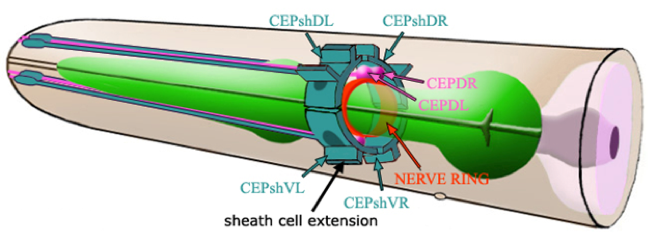Support cells and dopaminergic neurons
Brain iron increases significantly during ageing and is even further elevated in Parkinson’s disease. The death of dopaminergic neurons contributes to motor deficits characteristic of this disease. While iron is essential for normal function of these neurons, increased levels within these cells may be a trigger a newly identified form of cell death that drives neurodegeneration. The health of dopaminergic neurons is also supported by closely associated glial cells. However, the details of how glial dysfunction affects dopaminergic cell viability need further examination.
Aim
- Explore early life changes to the dopaminergic system through to neuronal death in late life.
- Understanding how the interactions between iron, glia and dopamine change through lifespan to provide new avenues for interventions to prevent cell death in Parkinson’s disease.

Figure: Cephalic sheath glia in C. elegans: CEPsh cells (Blue), CEP dopaminergic neurons (Pink), Nerve ring (Red)
Research team
Supervisor
Research group
Apply to take part in this project
Student applications
Students who are applying to study at The Florey can register their interest in this project. Refer to our step-by-step guide to help you with your application
Contact us
If you’re interested in learning more about this project please contact our team
